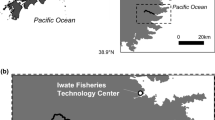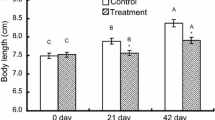Abstract
Oxygen consumption, ammonia excretion and fish swimming speed were measured in fish induced to swim by optomotor reaction in a circular metabolism chamber. The relationship between the swimming speed and fish metabolism described by exponential equations allowed the extrapolation to the standard metabolism, i.e. at zero swimming speed. The partitioning of the catabolised protein in the energy supply was estimated based on AQ (volume of ammonia/ volume of oxygen) values. Weight specific standard metabolism, as expressed by the ammonia excretion rate, decreased by one order of magnitude in coregonids as the fish grew from 20 to 780 mg body weight. The slope of the relationship between oxygen uptake and swimming speed decreased in coregonid ontogenesis. In salmon, after 12 days of fasting 28% of energy used was derived from protein, whilst coregonid juveniles utilized mostly lipid. Active swimming in fasted juveniles of coregonid, as well as in salmon, led to the accelerated utilization of protein as a source of energy, based on AQ coefficients. In juveniles acclimated to a range of water temperatures from 14 to 26°C, the changes in standard or active metabolic rate (expressed as oxygen uptake or ammonia excretion) were described by Q10 coefficients. They were generally higher for the ammonia excretion rate than for the oxygen uptake rate and for active metabolism than for standard metabolism. Utilization of protein as energy for swimming differed significantly between the species, being in general one order of magnitude higher in coregonids than in salmon. The use of protein for swimming activity tended to decrease during coregonid ontogenesis.
Similar content being viewed by others
References cited
Alliot, E., Djabali, M., Pastoureaud, A. and Thebault, H. 1984. Changes in the biochemical composition of tissues in juvenile sea bass during forced starvation. Biochem. System. Ecol. 12: 209–213.
Andre, E. 1944. Observations sur les Coregones. Rev. Suisse Zool. 51: 281–292.
Batty, r.S. 1984. Development of swimming movements and musculature of larval herring. (Clupea harengus). J. Exp. Biol. 110: 217–229.
Beamish, F.W.H. 1978. Swimming capacity.In: Fish Physiology, vol. VII. pp. 101–189. Edited by Hoar, W.S. and Randall, D.J. Academic Press, London.
Blaxter, J.H.S. 1969. Development: eggs and larvae.In: Fish Physiology, vol. III. pp. 177–252. Edited by Hoar, W.S. and Randall, D.J. Academic Press, London.
Brett, J.R. 1952. Temperature tolerance in young Pacific salmon, genusOncorhynchus. J. Fish. Res. Bd. Can. 9: 265–309.
Brett, J.R. and Glass, N.R. 1973. Metabolic rates and critical swimming speeds of sockeye salmon (Oncorhynchus nerca) in relation to size and temperature. J. Fish. Res. Bd. Can. 30: 379–387.
Cameron, J.N. and Heisler, N. 1983. Studies of ammonia in the rainbow trout: physico-chemical parameters, acid-base behaviour and respiratory clearance. J. Exp. Biol. 105: 107–125.
Cowey, C.B. 1980. Protein metabolism in fish.In: Protein Deposition in Animals. pp. 271–298. Edited by Buttery, P.J. and Lindsay, D.B. Butterworths, London.
Dabrowski, K. 1984. The feeding of fish larvae: present state of the art and perspectives. Reprod. Nutr. Develop. 24: 807–833.
Dabrowski, K. 1986. A new type of metabolic chamber for the determination of active and postprandial metabolism in fish. J. Fish Biol. 28 (in press).
Dabrowski, K. and Kaushik, S.J. 1984. Rearing of coregonid (Coregonus schinzi palea Cuv. et Val.) larvae using dry and live food. II. Oxygen consumption and nitrogen excretion. Aquaculture 41: 333–344.
Dabrowski, K. and Kaushik, S.J. 1985. Rearing of coregonid (Coregonus schinzi palea Cuv. et Val.) larvae using dry and live food. III. Growth of fish and the developmental characteristics related to nutrition. Aquaculture 48: 123–135.
Dabrowski, K., Kaushik, S.J. and Luquet, P. 1984a. Metabolic utilization of body stores during the early life of whitefish.Coregonus lavaretus L. J. Fish Biol. 24: 721–729.
Dabrowski, K., Charlon, N., Bergot, P. and Kaushik, S.J. 1984b. Rearing of coregonid (Coregonus schinzi palea Cuv. et Val.) larvae using dry and live food. I. Preliminary data. Aquaculture 41: 11–20.
De Silva, C. 1974. Development of the respiratory system in herring and plaice larvae.In: The Early Life History of Fish. pp. 465–486. Edited by Blaxter, J.H.S. Springer-Verlag, Berlin.
De Silva, C.D. and Tytler, P. 1973. The influence of reduced environmental oxygen on the metabolism and survival of herring and plaice larvae. Neth. J. Sea Res. 7: 345–362.
Driedzic, W.R. and Hochachka, P.W. 1978. Metabolism in fish during exercise.In: Fish Physiology, vol. II. pp. 503–543. Edited by Hoar, W.S. and Randall, D.J. Academic Press, London.
Duthie, G.G. and Houlihan, D.F. 1982. The effect of single step and fluctuating temperature changes on the oxygen consumption of flounders,Platichthys flesus (L.): Lack of temperature adaptation. J. Fish Biol. 21: 215–226.
Edsall, T.A. and Rottiers, D.V. 1976. Temperature tolerance of young-of-the-year lake whitefish,Coregonus clupeaformis. J. Fish. Res. Bd. Can. 33: 177–180.
Ehrlich, K.F. and Muszynski, G. 1982. Effects of temperature interactions of physiological and behavioural capacities of larval California grunion: adaptation to the plankton environment. J. Exp. Mar. Biol. Ecol. 60: 223–244.
Evans, D.O. 1984. Temperature independence of the annual cycle of standard metabolism in the pumpkinseed. Tran. Am. Fish. Soc. 113: 494–512.
Fauconneau, B. 1984. The measurement of whole body protein synthesis in larval and juvenile carp (Cyprinus carpio). Comp. Biochem. Physiol. 78B: 845–850.
Fauconneau, B., Aguirre, P. and Bergot, P. 1986. Protein synthesis in early life of coregonids: Influence of the temperature and feeding. Arch. f. Hydrobiol. Beih. Ergebn. Limnol. 22 (in press).
Forstner, J., Hinterleitner, S. Mahr, K. and Wieser, W. 1983. Towards a better definition of “metamorphosis” inCoregonus sp.: Biochemical, histological, and physiological data. Can. J. Fish. Aquat. Sci. 40: 1224–1232.
Henry, J.A.C. and Houston, A.H. 1984. Absence of respiratory acclimation to diurnally-cycling temperature conditions in rainbow trout. Comp. Biochem. Physiol. 77A: 727–734.
Holeton, G.F. 1971. Respiratory and circulatory responses of rainbow trout larvae to carbon monoxide and to hypoxia. J. Exp. Biol. 55: 683–694.
Hunter, J.R. 1972. Swimming and feeding behaviour of larval anchovy,Engraulis mordax. Fish. Bull. U.S. 70: 821–838.
Ivlev, V.S. 1962. Active metabolism in young Baltic salmon (Salmo salar). J. Ichthyol. 2: 158–168.
Jezierska, B., Jowko, G. and Korwin-Kossakowski, M. 1979. Respiratory metabolism of carp larvae under constant and cyclically fluctuating temperature conditions.In: Cultivation of Fish Fry and Its Live Food. pp. 243–255. Edited by Styczynska-Jurewicz, E., Backiel, T., Jaspers, E. and Persoone, G. Europ. Maricult. Soc. Publ. 4, Bredene, Belgium.
Johnston, I.A. and Goldspink, G. 1973. A study of the swimming performance of the crucian carpCarassius carassius (L.) in relation to the effects of exercise and recovery on biochemical changes in the myotomal muscle and liver. J. Fish Biol. 5: 249–260.
Kaushik, S.J., Dabrowski, K.R., Dabrowski, H., Olah, E. and Luquet, P. 1983. Utilization of dietary urea in rainbow trout. Ann. Nutr. Metab. 27: 94–106.
Kaushik, S.J., Dabrowski, K. and Luquet, P. 1982. Patterns of nitrogen excretion and oxygen consumption during ontogenesis of carp (Cyprinus carpio L.). Can. J. Fish. Aquat. Sci. 39: 1095–1105.
Kirsch, R. and Nonotte, G. 1977. Cutaneous respiration in three freshwater teleosts. Respir. Physiol. 29: 339–354.
Lauff, M. and Hofer, R. 1984. Development of proteolytic enzymes in fish and the importance of dietary enzymes. Aquaculture 37: 335–346.
Lindroth, A. 1965. First winter mortality of Atlantic salmon parr in the hatchery. Can. Fish Cult. 36: 23–26.
Lindsey, C.C. 1978. Form, function, and locomotory habits in fish.In: Fish Physiology, vol. VII. pp. 1–100. Edited by Hoar, W.S., and Randall, D.J. Academic Press, London.
Matjukhin, V.A. 1973. Bioenergetics and Physiology of Fish Swimming. Izd. Nauka Sibirsk. Otd., Novosibirsk.
Matsuoka, M. and Iwai, T. 1984. Development of the myotomal musculature in the red sea bream. Bull. Jap. Soc. Sci. Fish. 50: 29–35.
Miller, R.B., Sinclair, A.C. and Hochachka, P.W. 1959. Diet, glycogen reserves and resistance to fatigue in hatchery rainbow trout. J. Fish. Res. Bd. Can. 16: 321–328.
Muravskaya, Z.A. 1978. Peculiarities of nitrogen metabolism in fish during swimming.In: Some Aspects of Physiology and Biochemistry of Total and Active Metabolism in Fish. pp. 87–121. Edited by Shulman, G.E. Naukova Dumka, Kiev.
Nag, A.C. and Nursall, J.R. 1972. Histogenesis of white and red muscle fibres of trunk muscles of a fishSalmo gairdneri. Cytobios 6: 227–246.
O'Connell, C.P. 1981. Development of organ system in the Northern Anchovy.Engraulis mordax, and other teleosts. Amer. Zool. 21: 429–466.
Oikawa, S. and Itazawa, Y. 1984. Allometric relationship between tissue respiration and body mass in carp. Comp. Biochem. Physiol. 77A: 415–418.
Oliver, J.D., Holeton, G.F. and Chua, K.E. 1979. Overwinter mortality of fingerling smallmouth bass in relation to size, relative energy stores, and environmental temperature. Trans. Am. Fish. Soc. 108: 130–136.
Peer, M.M. and Kutty, M.N. 1981. Respiratory quotient and ammonia quotient inTilapia mossambica (Peters) with special reference to hypoxia and recovery. Hydrobiologia 76: 3–9.
Penney, R.K. and Goldspink, G. 1981. Temperature adaptation by the myotomal muscle of fish. J. Therm. Biol. 6: 297–306.
Rome, L.C., Loughna, P.T. and Goldspink, G. 1984. Muscle fiber activity in carp as a function of swimming speed and muscle temperature. Am. J. Physiol. 247: R272-R279.
Stickland, N.C. 1983. Growth and development of muscle fibres in the rainbow trout (Salmo gairdneri). J. Anat. 137: 323–333.
Turner, J.D., Wood, C.M. and Clark, D. 1983a. Lactate and proton dynamics in the rainbow trout (Salmo gairdneri). J. Exp. Biol. 104: 247–268.
Turner, J.D., Wood, C.M. and Hobe, H. 1983b. Physiological consequences of severe exercise in the inactive benthic flathead sole (Hippoglossoides elassodon): A comparison with the active pelagic rainbow trout (Salmo gairdneri). J. Exp. Biol. 104: 269–288.
Van den Thillart, G. and Kesbeke, F. 1978. Anaerobic production of carbon dioxide and ammonia by goldfish (Carassius auratus (L.). Comp. Biochem. Physiol. 59A: 393–400.
Van den Thillart, G. and Smit, H. 1984. Carbohydrate metabolism of goldfish (Carassius auratus L.). J. Comp. Physiol. B. 154: 477–486.
Van Waarde, A. 1983. Aerobic and anaerobic ammonia production by fish. Comp. Biochem. Physiol. 74B: 675–684.
Wardle, C.S. 1980. Effects of temperature on the maximum swimming speed of fishes.In: Environmental Fish Physiology. pp. 519–531. Edited by Ali, M.A.) Plenum Press, New York.
Weihs, D. 1980. Energetic significance of changes in swimming modes during growth of larval anchovy.Engraulis mordax. Fish. Bull. U.S. 77: 597–604.
Author information
Authors and Affiliations
Rights and permissions
About this article
Cite this article
Dabrowski, K.R. Active metabolism in larval and juvenile fish: ontogenetic changes, effect of water temperature and fasting. Fish Physiol Biochem 1, 125–144 (1986). https://doi.org/10.1007/BF02290254
Issue Date:
DOI: https://doi.org/10.1007/BF02290254




